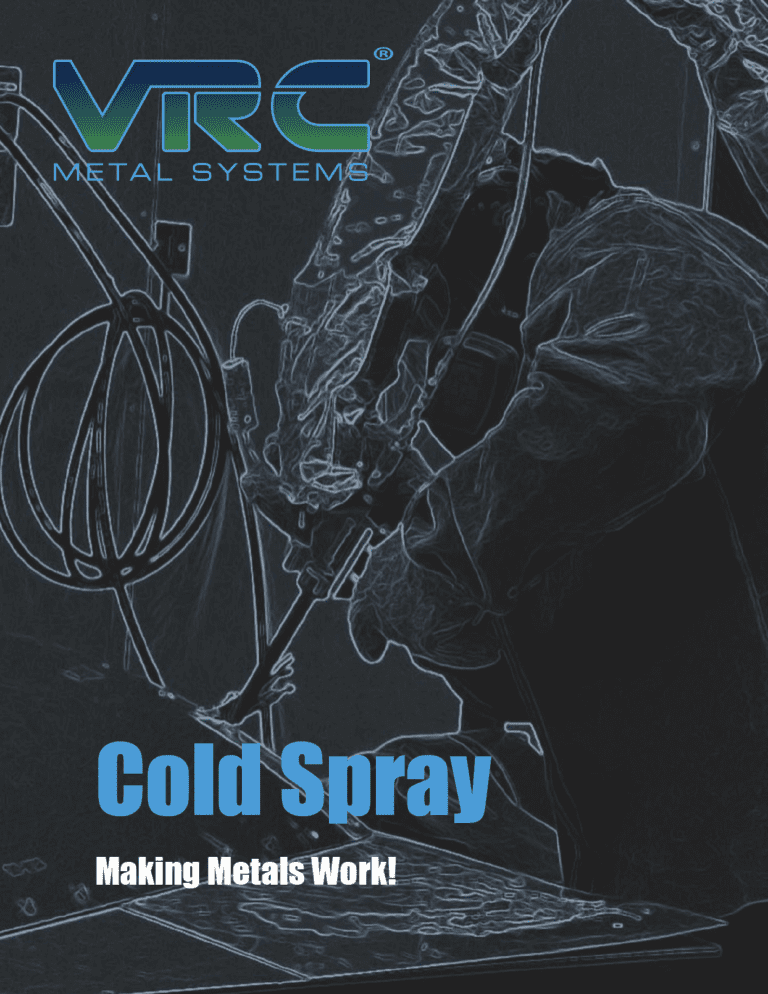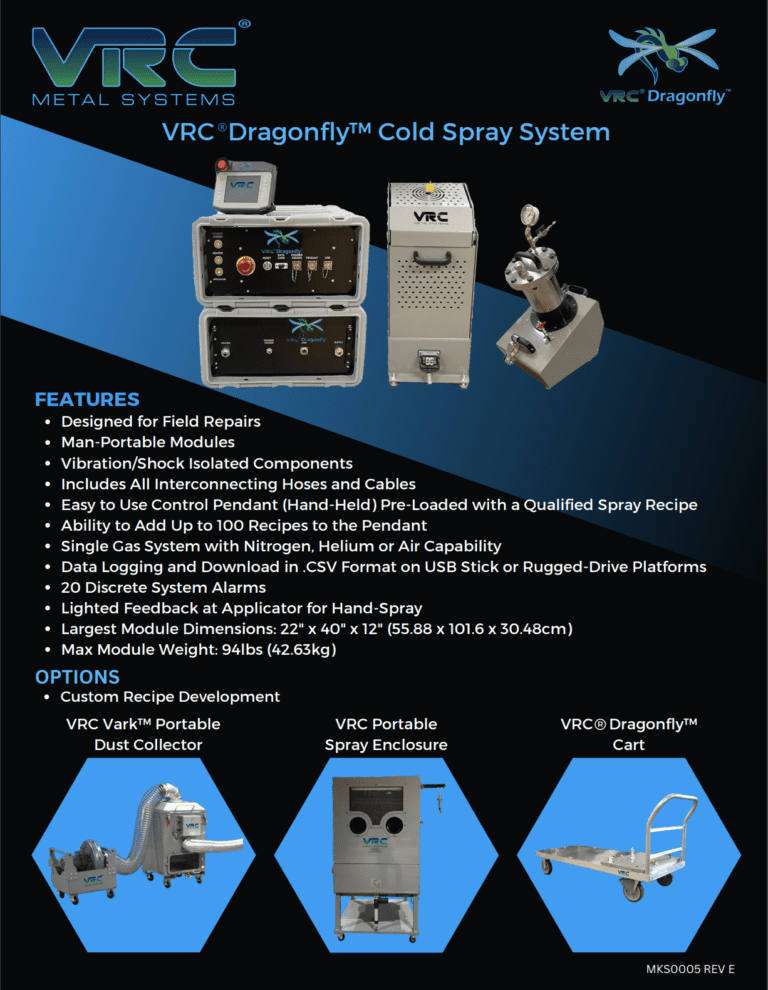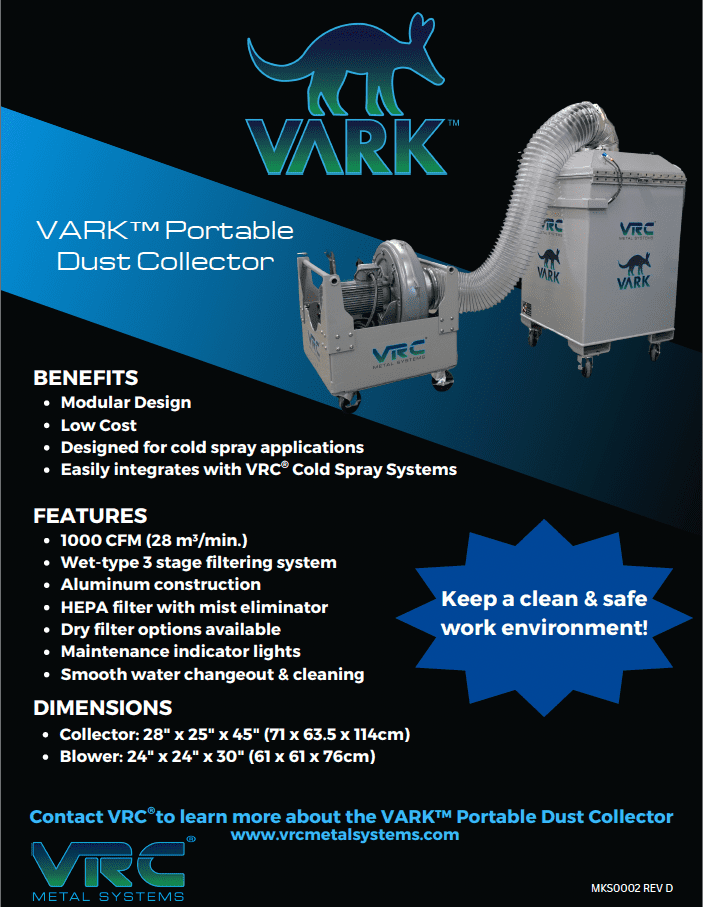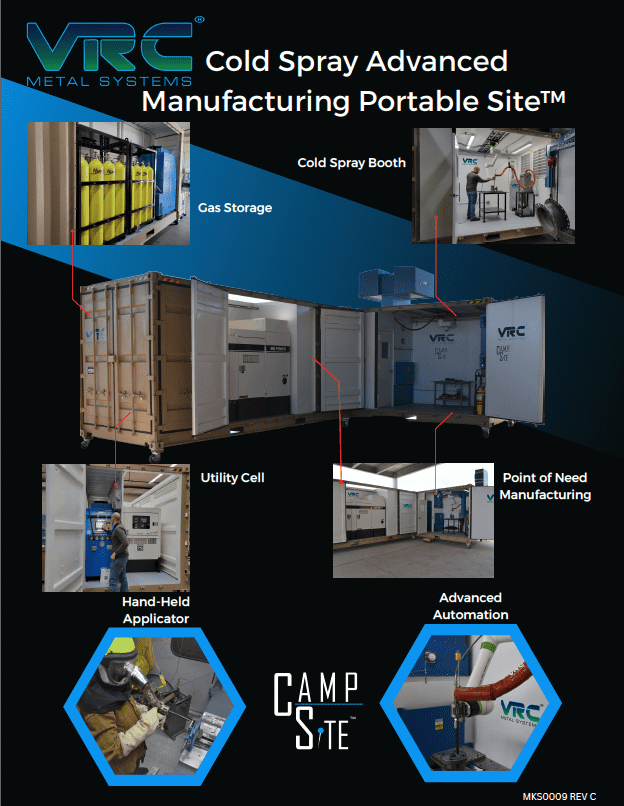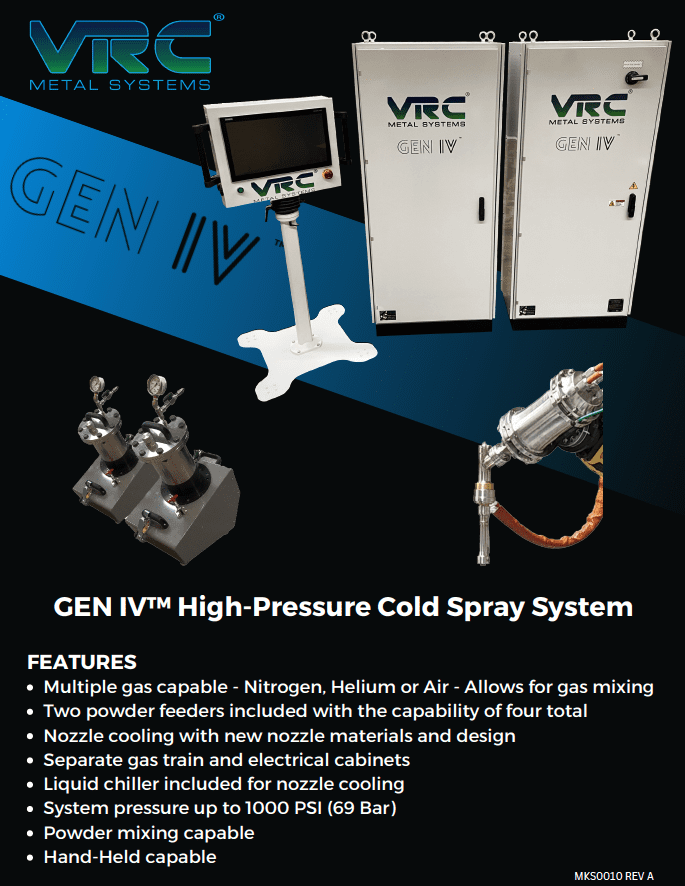Resources
Here you can find informational & demonstrative videos along with various marketing collateral and other documents for your education and interests about VRC Metal Systems and our products & services.
Videos
VRC Raptor Overview
Hey, I’m Kyle Johnson with VRC metal systems. We are a cold spray system provider and application development partner and today I’m going to talk about the Raptor cold spray system. This is the VRC Raptor cold spray system. It’s a high-pressure, ruggedized cold spray system for use in field repair or other deployed environments. So we’re going to take a look at the heater and powder feeder modules on the Raptor system. Again, these are contained within an environmental enclosure. On this side, we have a door that opens and we have our modules mounted on slide-outs. So here you’ll see the two modules of the Raptor system. The heater and the powder feeder modules. These modules can be unloaded from the drawer and located up to 25 feet from the Raptor system so you can move the process closer to your actual application.
This is the heater module. The heater module is the standard 21-kilowatt heating module and has an 800 C outlet temperature capability. This attaches to a hot gas hose, which transfers the hot gas from the heater to the applicator, which I will show you in a minute. This is the powder feeder module. Again it is portable and has a pressure vessel that contains a powder that can hold 1 to 1.5 liters of powder, depending on the material you are using.
Located on the top, we have some additional storage for other ancillary components. I mention the applicator handle. This is the standard VRC block-type applicator. We have the hot gas coming into the top port and powder feed gas coming through the end port that is blended in the applicator and injected into the nozzle. This is a supersonic converging/diverging nozzle where particles are accelerated out of the nozzle which they then impact a target and they form a coating.
This applicator can spray many different materials. Aluminum, steel, stainless steel, titanium, and even refractured materials like tantalum and niobium are possible with cold spray. The applicator itself is handheld. You can see the grip and some controls which can start and stop the cold spray process, the powder feeder, and also the system itself. It also has an LED feedback that provides the operator with a heads-up display of what state the system is in. The system is controlled by a flexible pendant unit that can be located up to 30ft from the system. This displays all the critical process parameters and control the system from system set points and as well as displays any alarms or process issues you might have.
Again, this is the VRC Raptor cold spray system by VRC Metal Systems. If you want to know more about VRC or the cold spray process in general, please visit our website at www.VRCMetalSystems.com or contact our sales team who can help to learn more about your application, handle process development to determine if cold spray is the right fit for you and determine if cold spray can help you and your business be successful.
Thank you
VRC Dragonfly Overview
Hey, I’m Kyle Johnson with VRC metal systems. I am going to show you today the VRC Dragonfly™, a hatchable cold spray system. The VRC Dragonfly™ is a modular cold spray system. It consists of four main modules; the electrical assembly, the gas train, the powder feeder, and the heater unit. The heaviest module weighs about 94 lbs and the rest of them are less than that. The largest module is 22in wide, 12in deep, and 40in long so these systems are very highly portable and fieldable cold spray systems.
The VRC Dragonfly™ system consists of four modules. The electrical enclosure, the gas train, and the heater and powder feeder modules. The electrical enclosure as you can see here is housed in a standard Pelican mil-spec case. It’s a shock-mounted case that’s able to absorb shock and vibration for drops and other incidental things that could happen. Same as the gas train, both are housed in the same shockproof cases. The electrical enclosure has connections for thermal couples and other process connections, a powder feeder, a heater, and a portable wet-type dust collector. The gas system has connections for your gas input as well as output for the powder feeder and heater modules. The VRC gas system can handle nitrogen gas and also helium and compressed air.
The system is controlled by a pendant and the pendant can store up to 100 recipes and it’s not just a single recipe system. Those recipes can be user-defined or they can be ordered from VRC Metal Systems as pre-approved, pre-qualified recipes that you can drop right into your process. We’ve really tried to design the system for simplicity so the operator can with a push of just a couple of buttons be able to start a spray process relatively quickly. The system has integrated alarms and also integrated data logging in both USB format and non-USB format for USB-denied environments.
The system also ships with heater and powder feeder modules. The powder feeder model, the VRC standard PF2 powder feeder, is capable of holding one liter of powder and it’s the same standard spec that’s used on the VRC Gen III™ and in VRC Raptor™ cold spray systems. The 21 kW heater is also used on VRC Raptor™ and Gen III™ cold spray systems. It is 21 kW of heating energy and is capable of 800 C temperature. Those two modules need to be located within about 10 ft of your spray application however you have some flexibility with the location of your control modules from your heater and powder feeder modules. These units can be up to 25 ft away from the heater and powder feeder modules, making them about 30 to 35 ft away from your spray process. So you have some flexibility with setup and again the system is designed to be functionally equivalent to our other larger, stationary cold spray systems, the VRC Raptor™ and VRC Gen III™. So recipes and processes that are developed in the lab can be translated to a field, portable environment very easily.
The system also works with the VRC Portable Wet-Type Dust Collector. This wet-type dust collector is approved for the collection of metal dusts per the NFPA 484 code. It’s a 1,000 CFM wet-type dust collector with HEPA after-filtering for recirculation inside of building space. It’s a portable design, 24 x 24in, and two portable modules.
You can also use this system with the VRC’s portable spray enclosure. The spray enclosure or glove box is about a 3-foot cube that’s integrated with a downdraft table that integrates perfectly with our wet-type dust collector system, It is optimized for a 1000 CFM flow rate and can contain metal dust that comes off of the process.
That is the VRC Dragonfly™ cold spray system. Contact VRC Metal Systems at www.VRCMetalSystems.com for more information on the Dragonfly™ or other ancillary equipment.
Thank you
C.A.M.P SITE Walk Around
My name is Chris Kleus and I am a project manager for the C.A.M.P. Site™ system and I’m going to give you a quick walk-through. We will start out here on this side of the system, and show you the grandiose unit. This here is the generator, it generates the power to support the whole unit. The idea behind the system is to be self-supporting so you don’t need to hook up any local utilities or have a gas supply on hand, the system can run and be self-supporting doing everything you need to do without any connections other than a water connection for the dust collector.
We’ll walk around to the other side here and I’ll show you the business end of the compressor and the generator and will get it fired up so we can walk you through the inside. This is the control end control the generator and this unit supplies power to everything. Cold spray is a very power-intensive process so we have 480-volt, 3-phase electrical coming in and out of this unit. It’s 125 KVA rated and we’re supplying 110 amps and it powers are cold spray system, it powers our compressor, it powers our dust collector and the robotic system, and all the lights and electrical on the inside. We will get that guy fired up and on the left side here is our compressor which is the other kind of key factor to being a self-supporting, self-sustaining system. So we supply compressed air at very high pressure, up to 4500 PSI for sprays, and storage tanks are in this container, in this channel but behind the compressor. We’ve got 24 bottles, two 12-packs, each capable of 4500 PSI so we have enough gas on hand. Depending on the recipe you are using, you can potentially get a spray of 8 hours out of this system.
So this is the inside of the utility cell that I just introduced you to. On the backside right behind this wall, we have the generator here, behind this wall we have compressed gas and the compressor. Gas comes in through this regulator, a dome-operated regulator that has the capability of up to 6000 PSI and we regulated down to system pressure at the wall here. All the power coming in from the generator comes in through this main panel and we get it distributed throughout the system through that sub-panel and the transformer. These umbilical cords are here and here. We’ve got gas umbilical, and electrical umbilical, and tie the two cells together.
What we have have here in the lab is we’ve got this workbench with a built-in toolbox shop, chock-full of tools already; ready for use. Nice workspace. We’ve got a flammables cabinet underneath here and we’ve got a little AC unit that we can plug in. It’s got AC, heat, and dehumidify so depending on what the outside conditions are, or the inside conditions we can kind of control the atmosphere for the operator.
So then when we walk into the cold spray cell, the two are connected. We’ve got a nice weathertight seal between the two. The dust collector for the cold spray operations and then inside is our spray booth. In our cold spray booth, we got the dust collector here pulling in 5500 CFM to keep this place evacuated from any fugitive dust. Then we’ve got our CRX10 collaborative robot set up ready to go. We have a fixture table here, we got it all setup and ready to spray. On the left-hand corner in the back, we’ve got the gas train for the VRC Raptor™ cold spray system. We have our powder feeder mounted on this stand below, the heater on top. We have this corbel hoist, and jib crane that we can extend in the event we have a very large part that we want to bring into the cell. We can move the table out and we can deploy this outside this bi-fold door, using this chain hoist sitting on the floor here. We can bring in you know anything else about 500 lb to spray inside. I also wanted to point out that our robot is mounted inverted and on linear rails so depending on how big the part is or even if you want to spray on a large vehicle if it’s sitting outside, they can open up these doors and we can slide the robot to the edge of the door frame and we can potentially spray on items outside of the cell.
One last feature we have is this pass-through right here. So if you want to do a hand spray outside then you just lift up these little clamps here. Lift off the heater and the powder feeder, take them outside and we can route hoses from the gas train through there, plus the control lines, mount the applicator on a handle and you can deploy it outside leaving this close and do you spray outside.
VRC Cold Spray Active Pipe Leak Repair
In this video, we are demonstrating a hands-free repair of an active pipe leak using VRC’s high-pressure cold spray system. Cold spray, also known as supersonic particle deposition is the spraying of micron size metal powder at a high velocity so that the particles deform themselves and the parts surface, promoting not just mechanical interlock but also metallurgical bonding.
VRC’s high-pressure cold spray systems can obtain much higher adhesion strength and better properties than low-pressure systems. Particle velocities of the VRC systems can be from mach 2 to mach 3 and do not have any heat-affected zones and there is no upper limit to the deposit thickness. The pipe is pressurized at 60 PSI. Notice how fast the cold spray is building up onto the pipe. In a matter of just a few minutes, the hole will be filled and the leak will be completely sealed.
A high-pressure cold spray impinging jet creates a high-pressure stagnation zone on the part that is being sprayed and when the nozzle is reasonably close to the substrate. This allows the substrate to overcome the leak pressure. The particles achieve full strength immediately on impact and knock debris and fluid out of the way to create a direct solid-state bond with a substrate. Unlike fusion processes, cold spray does not have to cool and solidify before reaching full strength. At this point, the leak is completely sealed. The pipe was successfully pressure tested to 1000 PSI.
VRC’s high-pressure cold spray has many other applications such as dimensional restoration and repair, corrosion-resistant coatings, wear-resistant coatings, additive manufacturing, high-strength dissimilar material coatings, field repair, and EMI shielding. To find out more about VRC Metal Systems and if cold spray is the right solution for your application, please visit our website at www.VRCMetalSystems.com or give us a call at 605-716-0065


